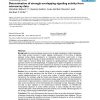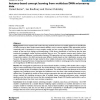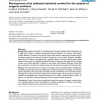BMCBI
2006
13 years 11 months ago
2006
Integration of heterogeneous data types is a challenging problem, especially in biology, where the number of databases and data types increase rapidly. Amongst the problems that o...
BMCBI
2006
13 years 11 months ago
2006
Background: Mitochondria are sub-cellular organelles that have a central role in energy production and in other metabolic pathways of all eukaryotic respiring cells. In the last f...
BMCBI
2006
2006
On single and multiple models of protein families for the detection of remote sequence relationships
13 years 11 months ago
Background: The detection of relationships between a protein sequence of unknown function and a sequence whose function has been characterised enables the transfer of functional a...
BMCBI
2006
13 years 11 months ago
2006
Background: As numerous diseases involve errors in signal transduction, modern therapeutics often target proteins involved in cellular signaling. Interpretation of the activity of...
BMCBI
2006
13 years 11 months ago
2006
Background: Benchmarking algorithms in structural bioinformatics often involves the construction of datasets of proteins with given sequence and structural properties. The SCOP da...
BMCBI
2006
13 years 11 months ago
2006
Background: Many dimeric protein complexes bind cooperatively to families of bipartite nucleic acid sequence elements, which consist of pairs of conserved half-site sequences sepa...
BMCBI
2006
13 years 11 months ago
2006
Background: A great deal of effort and expense are being expended internationally in attempts to detect genetic polymorphisms contributing to susceptibility to complex human disea...
BMCBI
2006
13 years 11 months ago
2006
Background: Various statistical and machine learning methods have been successfully applied to the classification of DNA microarray data. Simple instance-based classifiers such as...
BMCBI
2006
13 years 11 months ago
2006
Background: Unigenic evolution is a powerful genetic strategy involving random mutagenesis of a single gene product to delineate functionally important domains of a protein. This ...
BMCBI
2006
13 years 11 months ago
2006
Background: Microarray technology is generating huge amounts of data about the expression level of thousands of genes, or even whole genomes, across different experimental conditi...




